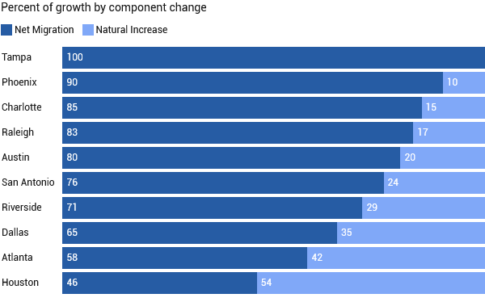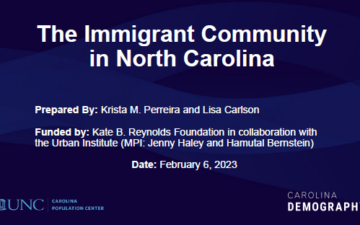Raleigh, Charlotte make top 10 list for fastest-growing large metros in the United States

Nationally, there are 384 metropolitan statistical areas (MSAs), which are defined as economically integrated sets of counties with a core central city with a population of 50,000 or more.
MSAs can be located within one state, or they can span across multiple states. They range in size from Carson City, Nevada (58,933) to the New York-Newark-Jersey City MSA (19,768,458) which crosses New York, New Jersey, and Pennsylvania.
Within and including North Carolina, there are 17 unique metro regions, ranging from Goldsboro (116,835) to Charlotte-Concord-Gastonia (2,702,046 across NC and SC). Fifty-six of these MSAs are what we might consider “large” metropolitan areas, with a population of one million or more residents.
There are also 543 micropolitan statistical areas, which similar areas but with populations between 10,000 and 50,000 people.
From 2020 to 2021, U.S. metro areas grew .1% as opposed to .2% for micro areas, a divergence from past trends where metro areas grew faster.
According to the Chicago Federal Reserve Bank, this development can be attributed to COVID related migration from large to medium and smaller density areas and natural declines from increased deaths and decreased births.
While a greater percentage of metro areas experienced population increases than micro areas (65% vs. 52.9%), the metro areas that did experience outward migration saw significant amounts of citizens leave. For example, Los Angeles County saw a net total of 179,757 residents leave and New York County net lost 113,642 residents.
From 2020 to 2021, there was a great amount of variance in the net population dynamics of metropolitan areas. Metro areas in the Northeast and in California led the population decreases. Nine of the top 10 counties in numeric declines were four of New York City’s five counties (New York, Kings, Bronx, and Queens), four California counties (Los Angeles, San Francisco, Santa Clara, and Alameda Counties), and Chicago’s Cook County were from the North or California. In contrast, Southern metro areas led in net numeric population growth. Two North Carolina metros were in the top 10 of numeric growth: Charlotte-Concord-Gastonia, NC-SC;s population grew by 31,381 and Raleigh-Cary, NC grew by 28,186.
The metro areas that led in numeric growth were not the same areas that led in percent growth. Of the top 10 metro areas in percent growth, none were also a top 10 area in numeric growth. This is representative of the general trend of migrants leaving large metro areas choosing to move to less dense areas instead of other metro areas. Of the fastest growing counties by percent growth, Myrtle Beach-Conway-North Myrtle Beach, SC-NC, which includes Brunswick County, NC, ranked third at 3.7% growth from 2020 to 2021.
Growth can take place in a population in one of two ways. First, an area can have more babies born than residents die. This is referred to as natural increase.
Second, more people can move into an area than move out. This is referred to as net migration. Both processes drove growth in the nation’s large, fast-growing metros, but net migration was the more important factor.
For nine of the 10 highest-growing metros, net migration made up at least half of the increase in population. In Tampa, while there was a natural decrease in the population, i.e., more residents died than were born, such a large amount of people moved there that it still found itself to be one of the nation’s highest-growing metros.
The two North Carolina metros amongst the top 10, Charlotte and Raleigh, experienced relatively high shares of their population increases in the form of migration at 85% and 83% respectively.
Need help understanding population change and its impacts on your community or business? Carolina Demography offers demographic research tailored to your needs.
Contact us today for a free initial consultation.
Contact UsCategories: Carolina Demographics, Migration, NC in Focus

The Center for Women’s Health Research (CWHR) at the University of North Carolina School of Medicine released the 12th edition of our North Carolina Women’s Health Report Card on May 9, 2022. This document is a progress report on the…

Dr. Krista Perreira is a health economist who studies disparities in health, education, and economic well-being. In collaboration with the Urban Institute, she recently co-led a study funded by the Kate B. Reynolds Foundation to study barriers to access to…

Our material helped the NC Local News Lab Fund better understand and then prioritize their funding to better serve existing and future grant recipients in North Carolina. The North Carolina Local News Lab Fund was established in 2017 to strengthen…
Your support is critical to our mission of measuring, understanding, and predicting population change and its impact. Donate to Carolina Demography today.